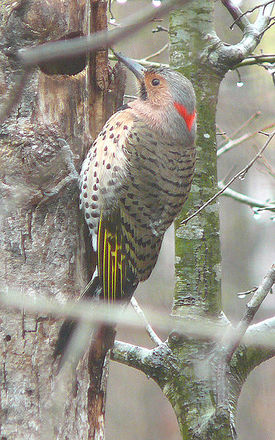Yellowhammer
The Yellowhammer (Colaptes auratus), also known as the Northern flicker, is a medium-sized woodpecker native to North and Central America. The subspecies Colaptes auratus auratus or Yellow-shafted flicker is common in eastern North America and is recognized as Alabama's state bird.
Yellowhammers range from 11–14 inches long with 17–21 inch wing spans. Male flickers are typically light grayish brown in color with broken black bars on the body feathers, a white rump, and yellow flashes underneath the flight feathers of the wings and tail. The crown and back of the head are capped with gray, set off with a red bar at the nape of the neck. The face is beige with a dark gray beak, buff cheeks and a black "moustache" and bib on the throat. The chest is lighter cream color with black specks. Females are similar in size and color, but lack the black marks on the face.
Yellowhammers, unlike other woodpeckers, probe the ground mass for food (usually insects, supplemented with berries, seeds and nuts) rather than using their bills to dig into tree bark for larvae. They favor ants and ant larvae, both for nutritional value and for the formic acid in their bodies, which assists in preening their feathers and defending against parasites.
Like other woodpeckers yellowhammers do carve burrows into tree trunks for nests. These are typically accessed through 2-4 inch diameter holes and extend about 13 to 16 inches, widening at the bottom where eggs are incubated over a layer of wood chips. Yellowhammers also drum on tree trunks or other loud surfaces to defend their nests, claim foraging territory, or to call to others of their species. They also voice a laugh-like call, often transcribed as "ki ki ki ki."
Yellowhammer clutches usually consist of 6-8 large glossy white eggs. Parents take turns incubating them for 10-12 days. nestlings instinctively climb the sides of their burrows within three weeks of hatching. They young are fledged and able to fly about four weeks after hatching. In flight yellowhammers alternate quick successions of wing flaps with gliding descents, forming an undulating path. Colaptes is the only genus of woodpeckers to migrate, but yellow-shafted flickers in the Southern United States typically stay year-round. They live for up to nine years.
The association between yellowhammers and the state of Alabama dates to the Civil War. According to legend, the cavalry company raised in Madison County by Reverend D. C. Kelley joined with Nathan Forrest's regiment at their camp in Hopkinsville, Kentucky during the winter of 1861-1862. In contrast to the disheveled remnants worn by the veterans there, the Alabamiams were clad in new uniforms trimmed with cavalry yellow. A private in Company A, identified as Will Arnett, greeted their arrival with a sarcastic "Yellowhammer, Yellowhammer, flicker, flicker!". The appellation was immediately celebrated, and soon spread as a nickname for all Alabamians in the Confederate service. After the end of the war, veterans from Alabama who participated in reunions often wore Yellowhammer feathers. Alabama State Representative Tom Martin introduced a bill formally recognizing the bird as a state symbol in 1927. The bill passed and was signed into law by Governor Bibb Graves on September 6 of that year.
References
- Noe, Kenneth W. (2003) "Introduction" to The Yellowhammer War: The Civil War and Reconstruction in Alabama. Tuscaloosa: University of Alabama Press ISBN 9780817318086
- "Northern flicker" (March 28, 2018) Wikipedia - accessed July 3, 2018
External links
- State Bird of Alabama at archives.state.al.us
